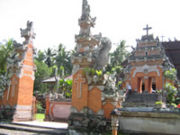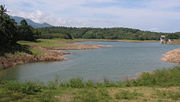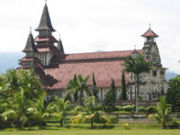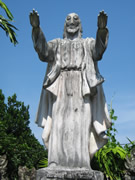Tampilan
On December 25 this year, in Palasari, Abianbase, Tuka, Untal-untal, Blimbingsari and Dalung, the birth of Christ will be commemmorated Balinese-style. Putu Wirata visited a number of these predominantly Christian villages to find out about the history of the Christian religion in Bali.
In the village of Palasari a bell toll breaks the silence at dawn, causing a flock of birds to take flight. As the dewy leaves start to glimmer with the first rays of sun, the people of Palasari dress themselves in traditional Balinese ceremonial costumes, and file out of their houses in throngs, following the bell chimes to their source. They go in through a gate which looks like the entrance to a Balinese temple, but which in fact leads to a high-ceilinged, rather ostentatious building, that echoes with the sound of people shuffling into pews. The bells have called them here to attend a Mass that is to proceed in High Balinese, and the date is December 25.
'BALINIZING' CHRISTIANITY
"We use Balinese visual metaphors because our ancestors are Balinese, and we respect the culture of our ancestors," says I Gusti Ngurah Wisnu Purwadhy Bernadus, a well-respected figure in Palasari and a lecturer in Agriculture at Denpasar's Udayana University. Although he is not a Hindu, Wisnu Purwadhy continues to preface his name with 'Gusti Ngurah', a reference to caste. But the name he was baptized by is Bernadus. Bernadus, like almost all the Catholics of Palasari, are descended from Balinese Hindus.
The 'Balinization' of the Christian religion, as evident in Palasari, can also be found in other predominantly Catholic and Protestant communities on the island, such as Blimbingsari in the district of Jembrana, and the villages of Abianbase, Tuka and Untal-untal in the district of Badung. Both Tuka and Blimbingsari even boast gamelan groups which perform every Palm Sunday.
"We are attempting to accommodate local cultural traditions within Christianity - what the missionaries termed 'inculturation' - by taking those parts of Balinese culture that fit comfortably with Christian theology," says Father Shadeg S.V.D, who oversees the Widia Wahana Library in Dalung, a Protestant village in the district of Badung. But this accommodative approach was slow to develop, and what lies buried beneath it is a history of conflict.
INVITATION FROM A KING
Bali's first contact with Christianity resulted from a letter sent by the King of Klungkung to the Vatican in 1635 expressing his eagerness to forge ties between the Balinese people and the Catholic Church. In his letter, written on a lontar leaf, the king wrote: "I would very much like for us to be close allies ... and would be happy to receive your representatives here to facilitate the conversion to Christianity of those Balinese people who so desire." The Vatican responded to the letter by dispatching missionaries to Bali. On the 11 March, 1635, two priests stationed in the Moluccas - Father Manuel Carualho and Azeuado S.J. - left for Bali. But their visit did not entail immediate efforts at Christianisation, and there are no records that any of the people of Klungkung were baptized during the priests' stay on the island.
Not until two centuries later - when the Catholic Church became more fervent about spreading the message of the Bible to all corners of the globe - were more missionaries sent to Bali. In 1866, European missionaries Van Eck and Jacob De Vroom arrived on the island. They chose to settle in the village of Jagaraga in the district of Buleleng. Only after living in Jagaraga for seven years did they succeed in converting their house-boy, who became the first Balinese to be baptised a Christian. His baptism as Nikodemus Nyoman Karangasem shocked his family and resulted in the tragic murder of de Vroom.
It took another sixty years for the next missionary to come to Bali. In 1931, Tsang To Hang, set forth from Makassar, eventually settling in the south of the island. His efforts at converting locals to Christianity sparked more violence, this time more widespread, in Tuka, Buduk, Pelambingan, Untal-untal, Carangsari and Abianbase. The conflicts resulted primarily from Tsang To Hang's confrontational approach, which put him at odds with the deeply-rooted Balinese mores and traditions, and were further compounded by the fact that Balinese society had yet to devise a social code to deal with religious differences within the community. Friction generally emerged around issues of subak (Balinese traditional irrigation system) and banjar (Balinese traditional administrative body) membership, as well as use of the communal cemetery.
SYNCRETIC MISSIONARY
"Only those missionaries who are humble, patient and learned will meet with success in Bali." On succeeding Tsang To Hang in 1935, it was this advice that Dutch born Father Yang Kersten, S.V.D took to heart. Its source was Mgr Petrus Noyen, a Timorese who had been in Bali twenty years earlier, and it helped Kersten to become one of the first to apply a more accommodative approach to missionary activity in Bali. On settling in Tuka, in the district of Badung, Kersten quickly developed a close friendship with I Wayan Diblug, and soon baptised him as Timotius. After only two years in Tuka, he oversaw the erection of its first church, the Mediterranean-style Church of the Holy Trinity (Satu Allah Tri Murti). Some years later, as Tuka's Christian community began to organise more systematically and established the Tuka Parish, a second church was erected, named the Church of the Almighty (Gereja Tri Tunggal Maha Kudus). More Balinese in style than its predecessor, the Church of the Almighty incorporated awantilan (traditional meeting hall) within its overall design.
By the time the Church of the Almighty was built, Kersten had long returned to Holland. But it was he who had originally conceived the idea of syncretic church design as a symbol of Christianity's recognition of the importance of local cultural traditions, thus inspiring another missionary, Simon Buis, to commission the the Church of the Sacred Heart at Palasari, an example later followed by the Tuka parish in building the Church of the Almighty. Another of Kersten's important contributions is the dictionary of Balinese grammar he wrote before returning to Holland. Since his departure, the number of Christians in Bali has steadily increased. In 1970, Bali's Christian population was officially put at 6000, and by 1994 had grown to around 31,000 (13,000 of them Catholics and 18,000 Protestants).
TO THE PROMISED LAND
In 1940, Putu Jenar joined fellow Christians and missionaries from Medangan in Gianyar when they were forced to flee their predominantly Hindu village. When they reached the other side of the island, in the district of Jembrana they found refuge in a small patch of newly cleared land deep within a dense jungle, and the nascent Protestant community of Blimbingsari.
The establishment of an exclusively Christian community, where Christians whose conversion brought them into conflict with their traditional villages could go to live, was another of Kersten's ideas that was put into practice by Simon Buis. In 1940, Buis submitted a request to the Assistant Resident in Singaraja to be granted 200 hectares of forest in Blimbingsari. His request was refused by the Assistant Resident who was concerned that conflict would flare up between the Protestant community, to whom he had recently granted a similar area of forest, and the Catholic community that Buis was proposing to establish. But Buis didn't give up. He resubmitted his request to the Balinese Council of Kings, was granted 200 hectares of forest in Pangkung Sente, and thus began the journey of Bali's Catholics to their promised land. Buis led 24 families to clear the dense forest, where many of the trees reached 30 metres in height and crocodiles, poisonous snakes and wild tigers abounded. To avoid being attacked by the animals, they lived in tree houses. Two months later, 22 more families arrived from the villages of Tuka, Beringkit (both in the district of Badung) more forest was cleared, huts were built, and the planning the village was commenced.
After some years, it became clear to the villlagers of Pangkung Sente that the land was very poor and could not be farmed, so Buis applied for, and was granted another 200 hectares of land nearer the river. Today, Palasari, is a sleepy town that neighbours the Hindu village of Ekasari, and has a population of around 2000 Christians.
BALINESE-GOTHIC
The first Balinese to become a Protestant Minister, I Made Rungu, is still spritely at one hundred years old. When he arrived in Blimbingsari, the forest was almost impenetrable. He has since watched the village develop into a model Balinese Christian community. Here, the entrance of the local church is marked by an apit surang - traditionally the gateway to a Balinese temple. The church yard is bordered by a penyengker, as the limiting wall of a Hindu temple is called, and the church garden is positioned according to the Balinese organisation of space.
Catholic Palasari has adopted a similar aesthetic. The roof of its Sacred Heart Church is tiered like that of a Hindu temple. In fact, the only thing differentiating it from a Hindu shrine is the presence of a large cross at its entrance.
The Sacred Heart Church is the work of a famous Balinese architect, Ida Bagus Tugur, whose other works include the Art Centre in Denpasar, and the Latto Mahosadi Museum at the School of Arts. A relatively recent addition to the town, it is Palasari's second church, the first having being commissioned in 1956 by Brother Ignatius Am de Vrieze. In 1988, Brother Ignatius commissioned Tugur to design a new church for Palasari. The Brother suggested a marriage of Gothic with Balinese architecture, and Tugur consequently came up with some drawings that had the steeple resembling the tiers of a Hindu temple, the bordering wall of the church yard as a penyengker, Balinese carvings dotted about, an apit surang at the entrance, and the layout of the interior according with the Balinese concept of trimandala. Needless to say, if the architecture of the Sacred Heart Church conveys a sense of Hindu-ness, its proceedings are a far cry from any Hindu ceremony. That is, the religious rites that take place beneath its towering steeple are, but for a single voice booming from the pulpit, silent and peaceful affairs.
Actually, elements of so-called 'Hindu Balinese' architecture are evident in churches all over Bali. "Brother Ignatius expressly wanted Balinese elements to be included in the design, so that Balinese Catholics would not forget their cultural heritage," explains Yosef Wora of the Sacred Heart Church. It is a sentiment that has its genesis in the small revolution prompted in Catholicism following the issuing of the Koncili Vatican of 1963, which allowed for the Eucharist to be performed in the local tongue rather than Latin which had hitherto been the case. "Even in Flores, church design incorporated elements particular to local shrines," said Father Yosef, himself a native of Flores. By making use of traditional symbologies, says Father Yosef, "we mean to show our respect for local cultures."
Although Balinese Hindus have not reacted as violently to the use of Balinese symbology in the practise of Christianity as they did to the missionary activity of the thirties, some critics continue to take offense to the use of Hindu attributes in church design, viewing it as part of a conspiracy to goad Hindus to convert to the Christian faith. Not only are Hindu attributes used in church design, the critics say, but also the name of the Christian Messiah has been 'Hinduised', so that Jesus is known locally as Sang Hyang Yesus (Hindus recognise Sang Hyang Widhi). The Bible, the Mass and the hymns have all been translated into Balinese so that Hindus who convert to Christianity don't feel too culturally dislocated.
Such criticisms are countered by the Bishop Vitalis Djebaris, who presides over Bali, Lombok and Sumbawa "What the missionaries meant by 'inculturation' was to make use of those elements of Balinese Hinduism which assist converts in their practise of Christianity. After all, it is hardly realistic to rip an ethnic community away from its roots and graft it onto a completely new cultural context," he argues. "Moreover, Christianity is making use of local cultural elements, not religious elements. Traditional ceremonial costume is the property of all Balinese, not only Hindu Balinese. Hindus in India wear a different costume, don't they?"
Not all Christians agree with Djebaris that 'inculturation' is a good idea. Some Balinese Christians who believe that the use of Balinese aesthetic in church design does little to assist public understanding of the Christian faith. And there are even some Christians who refuse to pray in Balinese-style churches, thus being forced to go outside their village to attend services.
The debate about church architecture in Bali has seeped beyond the boundaries of the local Christian community, passed through the dilpadiated corridors of the prestigious Udayana University, to-ed and fro-ed between members of the island's intelligentsia, and been immortalised between the pages of Denpasar-based intellectual Usadhi Wiryatnya's 1995 book, Bali di Persimpangan Jalan (Bali at the Crossroads). "The lotus seat and the tiers are indeed particular attributes of traditional Balinese architecture, not Hindu architecture," concedes Balinese cultural expert Ketut Sumadi in response to Djebaris' argument for distinguishing religion from culture. "But Balinese identity is so intertwined with the Hindu religion that discussion of the distinction between culture and religion becomes one of mere semantics. Rather than make use of symbols which have come to be widely recognised as Hindu, Balinese Christians should come up with new design elements for their churches, which retain the sense of being specifically 'Balinese' but have different names to those used in Hindu temples. This would also help develop our treasured architectural traditions."
- Photos and text by Putu Wirata
- Translated by Emma Baulch
- Source: Bali Echo -- Cover Story Section (p. 1), (p. 2), (p.3)
Back to Indonesian page/ Kembali ke halaman bahasa Indonesia
Bali has many interesting cultural quirks and among them are the Christian communities of Blimbingsari & Palasari in <a href="http://www.baliblog.com/travel-tips/maps-of-bali/map-of-west-bali.html">west Bali</a>. The story begins during the Dutch occupation when they fully took control of Bali in 1908. Until that time the Dutch operated a policy of cultural non-intervention, allowing the Balinese to conduct their own religious and cultural activities without hinder. Under this framework Christian missionaries were banned from Bali, but by 1932 a representative of the American Christian and Missionary Alliance, Tsang To Hang, has several hundred converts to Christianity. Most of the new Christians were from the Chinese community, but there were also some ethnic Balinese.
The new converts were told to destroy Hindu temples and encourage the Balinese to question the Hindu caste system. This created tension with the Balinese Hindu community who forbade their members from having any contact with the Christians. In 1939 the Dutch decided to banish the Christians to remote areas in the jungle where they would be less able to create religious tensions. The Balinese Protestants carved out a cross-shaped village in the highlands of west Bali named Blimbingsari. Located 30km NW of Negara, the village is going strong today and is set amongst some lovely countryside. In the center of the village is the church, which incorporates elements of a Balinese temple, candi bentar (split gate) at the entrance for example. In from the candi bentar is a Christian version of a kori agung (stone capped gate), traditionally the dividingl ine between the outside world and the inner sanctum of the temple. The kul kul (split-log bell tower) in the corner of the courtyard is similar to a Balinese temple, but it has a cross on the roof. Outside the church is a wooden sign saying “Gereja Kristen Protestan Di Bali” (Protestant Christian Church in Bali) The phone number is (0365)42192 in case you need it. In the center of the small intersection in the village is a stone block with crosses on all sides.
So Blimbimsari is still heavily Christian, even though riding up to the village one will see Muslims attending to their daily needs. This being west Bali, there are a considerable number of Muslims, Java not far away. The whole area around Blimbingsari feels tranquil, a mixture of forest and rice fields. To the north is the village of Ekasari and the reservoir. It occurred to me that this part of Bali would make a great hiking / camping area, sparcely populated with mountains tapering down to the west coast in the background.
Five kilometers SE of Blimbingsari is the Catholic village of Palasari. The church here is even more impressive, again located centrally next to the soccer field. Again the village is very neat a tide with manicured grass verges. Outside the church a couple of locals were selling small models of Jesus, their Chinese heritage an indicator of the past. Again an interesting cultural anomaly here in the highlands of west Bali. The route from Palasari down to the junction with the main road leading to Negara, is lovely. The route is lined with small Balinese villages decked out for Galungan, with penjors hanging for much of the way and family temples decorated in yellowed and white cloth. The lower section of the route down to the main road is untouched land covers with massive palms, a lovely area indeed.
The form of religious practice that occurs at Blimbingsari and Palasari are unique amalgams of Christianity and Balinese culture. Church structure, dress (traditional Balinese costume) offerings, dances etc. all come from Balinese culture, minus the Hindu religion. Inside the church at Blimbinsari this Sunday morning, the congregation sat on chairs and sang hymns to a gamelan accompaniment. A lead female voice created a surreal sound singing a hymn, with a slimmed down gamelan orchestra. Traditional Balinese dancing is practiced on both villages, the characters portrayed coming from the Bible instead of the Mahabharata and the Ramayana. For Christians visiting Bali from overseas, a trip to Blimbingsari and Palasari could be an enjoyable affair especially on a Sunday. You might call ahead to find a local contact, who can help you figure things out. Driving time from Kuta is 3 hours, so it might be better to stay somewhere closer, for example Medewi or Negara. There are local homestays in Blimbingsari and one hotel, Taman Wana Villas (0365)40970 (expensive).
History Of Christianity In Bali
When the Dutch governed Bali, it was very different to the island of Java. Bali was (and still is) predominantly Hindu. It had a very complex social system and was divided into 8 kingdoms, each ruled by a King. This made it very easy for the Dutch to deal with this island – they just needed to communicate with 8 kings. As a consequence, the Dutch authorities did not allow any missionaries onto the island. The official reason was that they did not want to “disturb the culture”.
However, in 1929 a Chinese Christian Tsang To Han , a representative of the Christian and Missionary Alliance was allowed entry to Bali to look after the Chinese Christians, many of whom had married Balinese wives. Later he was joined by another CMA minister. On Nov 11 1931, twelve full blooded Balinese were baptized – the very first Balinese converts. In 1932 another baptismal service took place in the river near the markets at Denpasar, in full public view. This caused a public sensation in Bali. For the Christians publicly declared that they had disposed of all their Hindu idols and superstitions. Soon another 75 were baptized. The Dutch Resident Officer in Denpasar ordered the two ministers to leave Bali, for they were clearly no longer just looking after the Chinese Christians, but were doing illegal mission work. When they left in 1933, there were 266 male converts. Despite the absence of their two leaders, the number of converts continued to grow.
The Hindu ruling class saw this as a threat to their power. The water supplies to the fields of the Christians were cut off, landlords refused to rent their farm land to them, and they were boycotted at every turn. Their crops were destroyed, their houses burned. Individual Christians were often attacked and beaten to death. It took great courage to maintain their faith in these trying conditions.
In 1934 the Dutch Reformed Church sent Dr Hendrik Kraemer to Bali to assess the situation. The result was that the church sent two Javanese ministers to care for the new converts, and so they came under the umbrella of the Dutch Reformed Church in east Java until 1942.
The ever increasing number of Christians became an embarrassment to the Dutch authorities who were committed to maintaining the Balinese culture. The whole social structure of Balinese society is inseparable from the Balinese Hindu religion with its castes and governing system. The Hindu leaders quite rightly saw Christianity as a threat to their power. As the violence escalated, the Dutch authorities in 1939 offered to give every Christian family 5 acres of land in a malaria infested piece of jungle at the west end of Bali. The Hindu’s were delighted with the solution. They were convinced the Christians would die of malaria, and those that would survive would be eaten by the tigers or be bitten by snakes.
Some 29 families set out to make the malaria infested swamp a place fit for living. They carved out a clearing in the shape of a cross , and built their village. They were leaderless, but supported one another and worked hard without any support from outside sources. They felt they were an “orphan” church. Yet under God’s hand they prospered, and developed their village into a model community and developed a Bali wide reputation for the quality of their rice, and the cleanliness of their village. This village is known as Blimbingsari and a few kilometres away, a satellite village, Ambyarsari was started.
The form of religious practice that occurs at Blimbingsari and Palasari are unique amalgams of Christianity and Balinese culture. Church structure, dress (traditional Balinese costume) offerings, dances etc. all come from Balinese culture, minus the Hindu religion.



